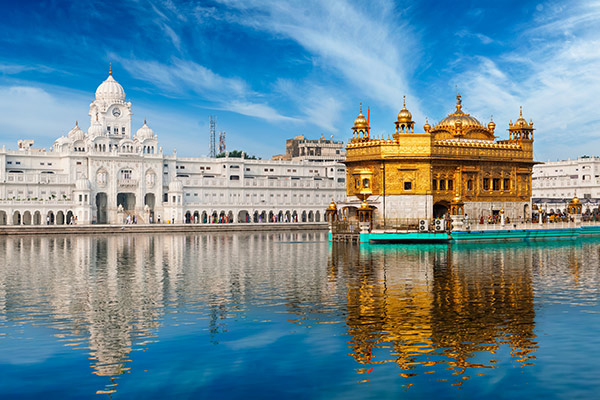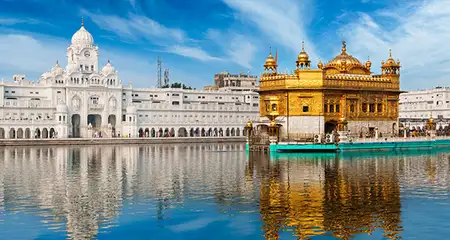The Golden Temple is the most celebrated monument in Amritsar, known as much for its spiritual significance as for its architectural beauty. Also called Harmandir Sahib or Darbar Sahib, this gurudwara stands as the holiest pilgrimage site of Sikhism and a prime tourist attraction in India. If Amritsar is the next place on your bucket list, make sure to include this spectacular place of worship in your itinerary. Being located in the heart of the city, it can be easily reached from your hotels in Amritsar.
Here is all that you should know about the Golden Temple in Amritsar, including its history, architecture, timings, and other interesting facts.
Golden Temple Information:
| Location | Amritsar |
| Timings | 4:00 am to 11:00 pm; every day |
| Entry Fee | Free |
| Still/Video Camera | Free |
| Date of Establishment | 1588 (origins) |
| Also Known as | Harmandir Sahib or Darbar Sahib |
| Special Note | You need to dress appropriately to enter the temple. Before entering the compound, you should remove your shoes and cover your head using a scarf as a sign of respect. |
Golden Temple: History
The construction of the Golden Temple marks an important chapter in the history of Sikhism in India. The foundation for the gurudwara was laid in 1581 and the construction was completed in 1588. In 1604, a copy of the Adi Granth, the principal scripture of Sikhism, was placed inside the gurudwara by Guru Arjan, the fifth Guru of the Sikhs. At that time, the site was called the Ath Sath Tirath. Over the years, the shrine was destroyed many times by the rulers of the Mughal Empire and the Muslim armies marching in from Afghanistan. Each time it was rebuilt by the Sikhs.
The current edifice of the gurudwara dates back to the 18th century. Its construction was started in 1764 under the supervision of Sultan-e-Quam Sardar Jassa Singh and was completed in 1776. Around half-a-century later, Maharaja Ranjit Singh renovated the gurudwara and decorated it with gold foil in 1830, which led the Harmandir Sahib to be known as the Golden Temple.
In 1984, the Golden Temple became a point of a conflict between some armed Sikh militants hiding within the premises of the holy shrine and the Indian Government. Indira Gandhi, the then prime minister of India, ordered the Indian Army to march into the shrine and carry out the Operation Blue Star. This military operation inside the Golden Temple left behind more than 1000 people dead, which included the militants, civilians, and soldiers. It also caused much damage to the shrine. Once again, the Sikh community came together and renovated the temple.
Golden Temple Architecture
The Golden Temple stands in the midst of a beautiful water body called Amritsar or Amrit Sarovar, from where the city derives its name. The shrine displays influences of different architectural styles, including the Indo-Islamic Mughal architecture and the Hindu Rajput architecture. It is a two-storied structure. While the lower level of the shrine is built out of marble, the upper level is covered in gold panels. A 750 kg gold gilded dome sits at the top of this structure. Even the doors of the shrine are covered in gold foil.
The interiors of the shrine are adorned with splendid floral motifs and frescos. Verses from the scripture of the Sikhs are etched in gold lettering on the arches of the shrine. There are four entrances to the Golden Temple complex, but only one to enter the gurudwara.
The gurudwara is comprised of many buildings which are located around the main sanctum and the water body. Of these, the most important is Akal Takht or one of the five seats of power in Sikhism. You can also see a clock tower, a museum, offices, and a community kitchen which is locally called a langar.
Daily Ceremonies and Langar in the Golden Temple
A number of ceremonies take place inside the Golden Temple on a daily basis. The main ceremonies are:
- Sukhasan or the Closing Ritual: This ceremony refers to the closing of the Guru Granth Sahib at night and placing it in a well-decorated palanquin. It is then carried to the Akal Takht on the first floor and the holy book is then put into a bed.
- Prakash or the Opening Ritual: Each morning, the Guru Granth Sahib is taken out of the Akal Takht and carried in a flower-decked palanquin to the sanctum of the Golden Temple. After the customary singing of kirtans, a random page is opened and read out loud.
- Free food: Everyday, thousands of people are fed free food from the community kitchen at the temple. This practice is known as langar in which everyone sits on the ground and enjoys the simple yet tasty vegetarian meal served there.
Golden Temple: Today
There’s no doubt that today, the Golden Temple stands as one of the top tourist places to visit in Amritsar. Scores of people visit the temple daily to experience its spiritual aura, tranquillity, and architectural beauty. The annual festival of Vaisakhi is celebrated with much pomp and glory at the Golden Temple every year. Apart from this, the birthday of Guru Nanak, the martyrdom day of Guru Teg Bahadur, and the birthday of Guru Ram Das are also celebrated with much fervor at the temple. During Diwali, the Golden Temple is spectacularly illuminated with earthen lamps or diyas.
Things to See in the Golden Temple Complex
The Golden Temple is part of a large complex that holds several attractions for the visitors. The major things to see in the Golden Temple complex include:
- Akal Takht, a site of authority in Sikhism
- Teja Singh Samundri Hall, the office of the temple management
- A clock tower, added by the colonial rulers
- Ber Trees, bearing various religious significance
- Sikh history museum
- Guru Ram Das Langar, comprising of a community-run kitchen and dining hall where free food is served 24 hours
Lesser Known Facts about Golden Temple
- The gurudwara has four entrances from the four directions. These entrances indicate that anyone from any direction is welcome to visit this place of worship.
- The foundation for the shrine was laid by Sai Hazrat Mian Mir, a Sufi saint.
- The British Government performed Akhand Paaths at this shrine during the First World War, seeking victory.
- The shrine attracts around 3 million visitors in a month.
- It offers the biggest langar in the World, feeding about one lakh people every day. This figure doubles during festive occasions.
- It is said that the water body of the Golden Temple has healing powers.
- Local legends say that the land for the shrine was gifted by none other than Mughal Emperor Akbar.
Attractions near Golden Temple
- Jallianwala Bagh (600 m)
- Gurudwara Baba Atal Rai (750 m)
- Jama Masjid Khairuddin (1.2 km)
- Durgiana Temple (1.3 km)
- Gobindgarh Fort (2.1 km)
- Hall Bazar (2.1 km)
- Mata Lal Devi Temple (3.2 km)
- Maharaja Ranjit Singh Museum (4.1 km)
- Khalsa College (5.4 km)
The holiness of the Golden Temple cannot be explained in words; it is something that can only be experienced. Once you are done exploring the temple, make sure to visit some of the other top historical places in Amritsar located nearby, including the Jallianwala Bagh. And do not forget to relish a meal at the famous Kesar Da Dhaba, which is one of the best restaurants in Amritsar, situated just 500 m from the Golden Temple complex.



























